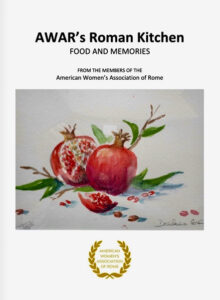 Sadly Co-Vid is still blocking travel for pleasure from the United States to Italy (down 90% in 2020), but I recommend three new books in English about Italian cuisine to whet your appetite and help you plan your next trip. In the meantime console yourself by enjoying their recipes.
Sadly Co-Vid is still blocking travel for pleasure from the United States to Italy (down 90% in 2020), but I recommend three new books in English about Italian cuisine to whet your appetite and help you plan your next trip. In the meantime console yourself by enjoying their recipes.
AWAR’S Roman Kitchen. The American Women’s Association was founded in 1955 by Clare Boothe Luce, still the only woman to have served as US ambassador to Italy. “During the lockdown last spring, we needed an initiative to keep the nearly 200 members of AWAR involved and in touch…” wrote Maureen Fant (www.maureenfant.com) in her January 26th press release. An archeologist, tour operator and guide, an award-winning cookbook author and translator, Maureen headed the 256-page volume’s team of the eight authors, artists, and photographers who collected the recipes, memories, and artwork of more than 40 AWAR members. “Since we hadn’t published a cookbook in 50+ years,” Maureen explained, “my idea was a no brainer. But there’s more to it. Every day, we read stories and saw news reports about the courage and dedication of brave doctors, nurses and other healthcare workers in Italy…We wanted to show our solidarity.”
Thus AWAR’s Roman Kitchen is technically not for sale, but available for a 20 euros donation as a spiral-bound paperback or e-book by clicking on www.awar.org/cookbook or awarcookbook@gmail.com. The proceeds will go Italy’s National Department for Civil Protection for PPE (personal protection equipment) for front-line health workers.
Its recipes are divided like most cookbooks: starters, soups and pasta, main dishes, vegan and vegetables, breads, sauces, sweets, and drinks: aperitivi, wines and disgetivi. About half are Italian, especially Roman, and the others are worldwide because almost all AWAR members are Americans, but several were born in Asia or Central or South America. Most measurements are given in both metric and US units. The recipes are interspersed with how-to-prepare advice: best way to cook pasta or trim a Roman artichoke; the locations of Rome’s several open-air markets; a list of ingredients probably unfamiliar at first to non-Italians like rabbit, capers, the many varieties of olives and vinegars; Italian table manners: don’t serve yourself wine and always peel fruit; plus common linguistic misunderstandings.
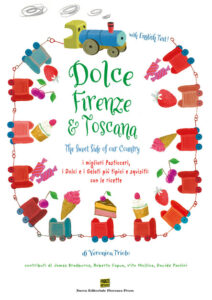
Like AWAR’s Roman Kitchen, Dolce Firenze & Toscana: The Sweet Side of our Country was written during the pandemic and by several authors. With only a few recipes at the end, this charming volume of 178 pages, is more a sweets guide to Tuscany than a cookbook. Its text, both in English and Italian, is divided into chapters: Signature Desserts, Select Desserts from Eateries and Inns, Delectable Bakeries, Gourmet Ice Cream, Bread and Baked Goods, Schools of Sweets, Wedding Day, Birthdays and Events. Each entry is a short profile of the chef, baker, gelataio, or cooking school with a description of their specialties. Their locations cover all of Tuscany, but some of the protagonists are not Tuscan-born, but Neapolitan, Bolognese, Sicilian, as well as Austrian and American. Its principal author is Roman-born, Tuscany-adoptee PR executive and blogger (Fragolosablog) Veronica Triolo; the contributors are Canadian naturalized-British James Bradburne, Director of Milan’s Brera Art Museum and adjacent Braidense Library; Neapolitan Roberta Capua, former Miss Italia and now TV-Star; Lucano-born, Varese-bred Vito Mollica, the executive chef of “Il Palagio” at Hotel Four Seasons Florence; and journalist and gourmet Davide Paolini from Galeata in Emilia-Romagna. Well-illustrated with photographs, the volume’s common denominator is a love of Tuscany and the splendid sweets to discover there; it’s available on IBS, Amazon, and Feltrinelli for 18 euros.

Veronica Triolo
Hot-off-the-press, The New Cucina Italiana: What to Eat, What to Cook & Who to Know in Italian Cuisine Today by Laura Lazzaroni was published on March 2, by Rizzoli New York. Price: $40 US. Available on Amazon.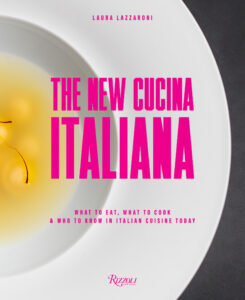
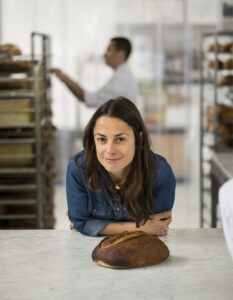
Laura Lazzaroni
An award-winning journalist and author, Laura Lazzoroni was the first Editor-in-Chief of Food and Wine Italia. Previously the New York correspondent of La Repubblica’s weekly, then features editor of L’Uomo Vogue in Milan, where she lives, she’s also the author of Altri Grani Altri Pani (Guido Tommasi Editore, 2017) and coauthor, with her mentor, the three-Michelin starred (the only one south of Rome) Abruzzese Niko Romito, of 10 Lezioni di Cucina (Giunti, 2015). She’s also an accomplished bread consultant, specialized in heritage wheat.

Romito’s Signature Roasted Cauliflowe
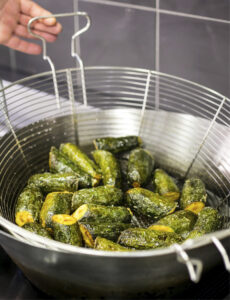
Lopriore’s Fried zucchini in “Scapece”
Purposely written for the American market, The New Cucina Italiana is both a cookbook with recipes and a travel guide with splendid photographs by renowned food photographer Alberto Blasetti. Available only in English for now and with its cooking measurements foolishly only in ounces and pounds etc, it’s divided into six chapters: “Mentors”: once painfully shy, self-educated Niko Romito already mentioned, who, according to Lazzaroni, “is the champion of a new league of extraordinary restaurateur who are shaping the movement of a ‘new cucina italiana’” and “self-proclaimed tech-grouch”, Paolo Lopriore, a “Marchesi Boy” and owner of “Il Portico” in Appiano Gentile, 11 miles south-west of Como; “Farmers and Foragers“, “Sunday Restaurateurs”; “Fine Dining Creatives”; “Pizzaioli” and “Forces of Neo-Osterie & Neo-Trattorie”. Lazzaroni’s aim, while not demeaning Italy’s already well-known and pluri-starred chefs, is to explain to Americans (but if the measurements had been added in metrics to all English-speakers) where they can find new young talents. They include more than 30 chefs and restaurateurs from ten regions in Italy: Piemonte, Lombardia, Veneto, Friuli-Venezia Giulia, Emilia-Romagna, Toscana, Lazio, Campania, Abruzzo, and Puglia. In her words Lazzaroni’s entries are “reinterpreting the greatest hits of Italian dining”, but are not yet known abroad. As a long–time eno-gastromomic journalist who’s traveled extensively and enjoyed the food in all 20 regions of Italy, I’ve only eaten in two of her locations so I’m not sure how well her entries are known even in Italy. Thus I hope Rizzoli soon publishes this book in Italian. Each entry includes a biographical profile and recipes. At the end of the book’s 255 pages is a list of Lazzaroni’s suggestions by region, a useful tool for future travelers. In the meantime until we are allowed to travel between regions I will visit the three in Lazio and publicize others to my friends in other regions. However, I’m curious why she covered only half of Italy. I find it particularly hard to believe there were no young talents awaiting her discovery in the Marche, a recently-appreciated touristic venue, or in gastronomically, but not only, unforgettable Sicily. So hopefully Lazzaroni is planning to write a sequel.
